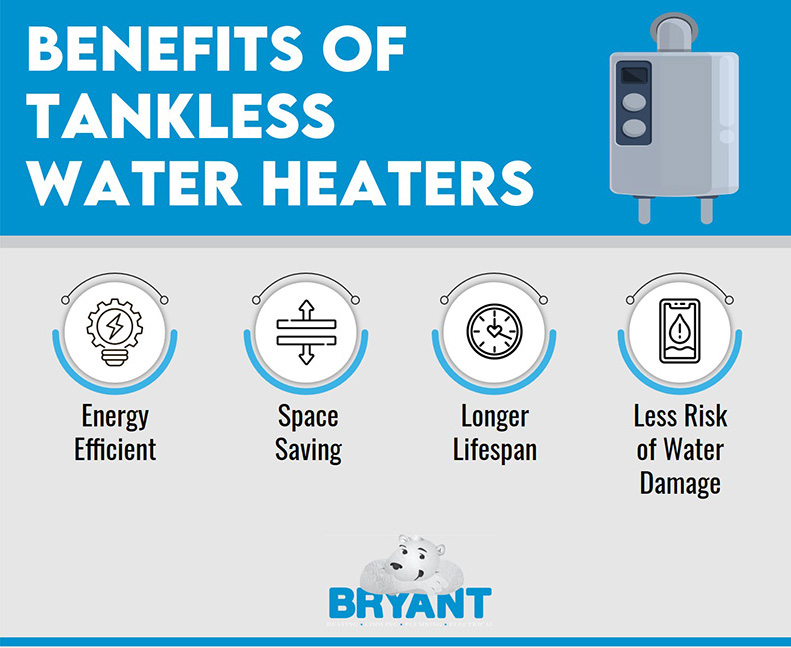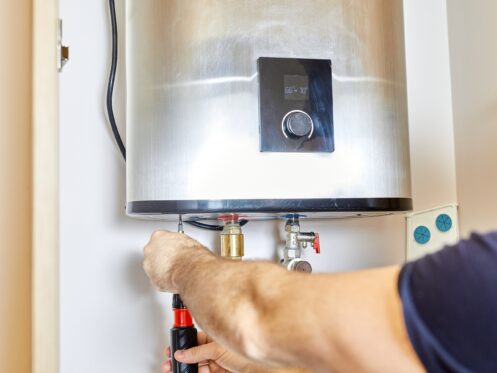Many people call tankless water heaters on-demand water heaters. This term reflects how tankless models deliver hot water instantly without storing it in a tank. They heat water only as needed, which can significantly reduce energy bills. Eliminating the tank also decreases the risk of leaks. If you are considering upgrading to a tankless water heater, there are plenty of reasons to make the switch.
How Tankless Water Heaters Work
A tankless water heater heats water as it flows through it. For example, when someone turns on a faucet, cold water flows into the heater. A heating element or gas burner rapidly heats the water to the desired temperature. Since this unit does not have a storage capacity limitation, it provides access to a virtually endless supply of hot water. The heater’s flow rate determines how many fixtures can operate simultaneously without affecting the water temperature.
Flow rates are typically measured in gallons per minute (GPM). Gauging a home’s flow rate is crucial. This process ensures that you select a tankless water heater with the appropriate capacity to meet the home’s unique needs. For an average-sized home, a tankless water heater with a flow rate of five to seven GPM usually suffices.
Benefits of Tankless Water Heater
Tankless water heaters offer several advantages over traditional heaters. They deliver higher energy efficiency and reduce the risk of water damage, among other benefits.
Endless Supply of Hot Water
If you want a home with an uninterrupted supply of hot water, you need a tankless water heater. When multiple people use hot water simultaneously, regular water heaters can quickly run out. This situation complicates getting ready in the morning or during busy family activities and makes it more difficult to enjoy a relaxing bath or shower.
With a tankless water heater that has the right flow rate, you can take a shower, run a load of laundry, and use the dishwasher all at the same time. If several people want to shower in different bathrooms simultaneously, this convenience becomes possible. This type of convenience can greatly improve your overall lifestyle.
Energy Efficiency

Tankless water heaters are much more efficient than traditional models due to their on-demand heating mechanism. Heaters with tanks store water and consume energy to keep it hot at all times. Because they experience standby heat loss, they waste a lot of energy. If you want a tankless model that maximizes energy savings, look for one with an ENERGY STAR label.
These water heaters save a family of four roughly $100 a year on energy bills compared to conventional models with tanks. Over a period of 10 years, the savings can easily exceed $1,000. In addition to helping you save money, the enhanced energy efficiency of tankless units means your home will have a smaller carbon footprint. Their popularity among eco-conscious individuals highlights their appeal to those who prioritize sustainable practices. They also assist homeowners in qualifying for green building certifications and incentives.
Space Saving
Due to their space-saving design, tankless water heaters suit any residential setting. Since they lack a tank, they are significantly smaller than traditional heaters. You can easily install them on the wall or beneath a cabinet, and some people even place them in tight spaces like attics or small closets.
Even if you live in a large home, a tankless unit’s compact size can free up valuable space for other uses. Ultimately, because tankless versions are smaller, they help keep a home organized and clutter-free.
Longer Lifespan
One of the most aggravating aspects of home appliances is that you must replace them periodically. Replacing appliances can be time-consuming and expensive. You not only need to choose a new appliance but also schedule an appointment with a plumber for the installation. After that, you have to wait for the removal of the old appliance and the installation of the new one.
A traditional water heater needs replacement every 10 to 15 years. However, with a large family, the lifespan of tank or tankless water heaters may be shortened due to increased usage. Tankless units have longer lifespans, which results in less time and money spent on replacements. With regular maintenance, tankless models can last up to 20 years or even longer.
Fewer Parts
Tankless water heaters have fewer parts than standard models. For example, tankless versions lack a tank, tank insulation, a dip tube, an anode rod, or a dedicated drain valve. This results in fewer parts that can malfunction. Additionally, tankless heaters operate more efficiently, leading to less wear and tear on their components. All of this results in fewer water heater repairs and breakdowns.
Reduced Risk of Water Damage
Regular water heaters have tanks, making them vulnerable to water leaks. Units with significant corrosion or rust are particularly susceptible. Leaks can go unnoticed for extended periods, causing substantial water damage. You don’t need to worry about tank leaks with a tankless version. Its design specifically reduces the risk of water damage and mold growth.
Considerations Before Switching
Tankless water heaters offer numerous advantages, but some considerations should be made before making the switch. First, tankless models typically cost more than traditional tank models, primarily due to the advanced technologies they employ. Additionally, assess whether your home needs upgrades to the gas lines, electrical panel, or venting system to accommodate a tankless unit. Making these modifications will increase the total installation cost.
Next, consider the maintenance requirements for tankless units. Just because they don’t have tanks doesn’t mean they require regular care. In fact, a plumber must flush the tankless unit at least once every 12 months. Flushing a water heater removes mineral deposits and sediment that accumulate over time, helping the heater perform better and use less energy. After flushing, we check the burners or heating components to ensure they function correctly.
Tankless water heaters have filters that require regular cleaning or replacement. Keeping the filter clean is crucial for homes with hard water. Minerals in the water accumulate and clog the filter, impacting the water heater’s efficiency. By maintaining a clean filter, you enhance performance and prevent clogging. Check the manufacturer’s recommendations for the appropriate maintenance and cleaning schedule for your specific model.
The last part of maintenance involves monitoring the venting system. Over time, venting systems can block and corrode. Dirt, debris, and bird nests are common causes of blockages. Condensation and acidic gases also typically cause corrosion issues. Removing the blockages ensures the heater can vent properly. We can address corrosion issues in venting systems by cleaning and treating the affected areas. If that is insufficient, we can fully replace the venting system.
Bryant Heating, Cooling, Plumbing & Electric can help you decide whether to upgrade your home with a tankless water heater. We also provide various plumbing services, such as drain cleaning and pipe repairs, to enhance your home’s functionality. Call Bryant Heating, Cooling, Plumbing & Electric today to schedule reliable plumbing services in Lexington, KY as well as Indiana and Ohio.



